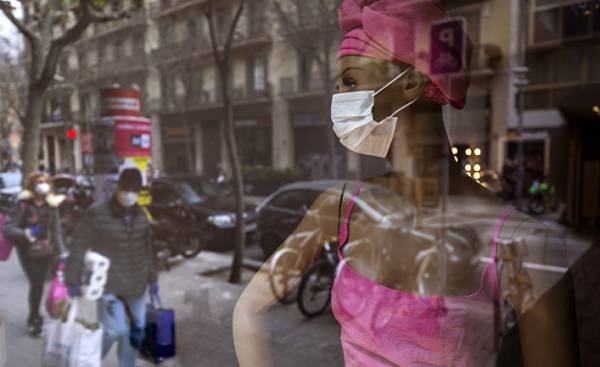
A growing body of research — including a recent publication in the journal “nature” (Nature), — argue that the coronavirus remains in the air in the form of aerosol particles. Although considered the evidence irrefutable is impossible, and such transfers are not documented, still raises questions about the mechanisms of infection.
While a generally accepted view that the virus, although highly contagious, spread through droplets produced by breathing, talking or coughing, but does not infect people particles that linger in the air for a few hours — unlike a number of other diseases like measles.
However, the study sparked academic debate, one of the most pressing issues around the new coronavirus, and in troubled times, when nerves to the limit. Flash in public places — prisons, slaughterhouses, close the call centers and restaurants — indicate the risks posed by the abolition of isolation.
Scientific literature is full of disturbing questions: is there any virus through the ventilation system? And when you take your clothes off, not shake you at the same time the virus particles back into the air?
Studies show that the virus is usually passed from person to person through relatively large respiratory droplets, which fly just a few metres away and quickly settle on the ground. You can catch, first touching the contaminated object fomit if scientific, — and then the face.
“Cases of air transfer is not registered, and, as is evident from the available data, the main force of the epidemic it is not,” concluded the researchers from China and the world health organization in February of a large-scale study.
However it was noted that, in some medical procedures, such as intubation — generated virus aerosols. And research in the Laboratory of the Rocky mountains under the auspices of the National Institute of Allergy and infectious diseases showed that sprayed with special equipment flying particles of the virus retain the ability to proliferate in cell culture, even after three hours.
In the article of scientists from Wuhan University in the journal “nature” reported that aerosol traces with traces of viral genetic material called RNA component was discovered in two hospitals, especially in poorly ventilated areas. The highest concentration of volatile particles was in a portable toilet where there was no ventilation. The RNA component found in the compartment where the hospital staff had removed protective gear and dressed.
This article is not reported whether there was a viable flying virus particles, that is, if they can generate a new infection.
“Although the infectiousness of the virus, discovered in the hospital premises, not established, we assume that SARS-CoV-2 can be transmitted through aerosol particles, the authors write. Our results show that the room ventilation, open spaces, disinfection of protective clothing, and proper use and disinfection of toilet areas to successfully reduce the concentration of RNA of SARS-CoV-2 in aerosols”.
Epidemiologist at the University of California, Irvine Andrew Noymer (Andrew Noymer) believes that the public should be wary of the new Chinese study as the PCR test (polymerase chain reaction) does not allow to distinguish viable from non-contagious virus genetic material.
“A test of the viability of virus — it is more accurate and done on cell culture in this study was not conducted,” — said Noymer.
A disturbing message came from a restaurant in Guangzhou, China, where one asymptomatic carrier alleged to have infected nine. Scientists have suggested that transmission of virus aerosol between tables has speeded up the vent.
“It just shows what a terrible mess from the popular misconceptions that between the aerosol and respiratory droplets is a fundamental difference, Donald Milton (Donald Milton), Professor of hygiene in the School of public health at the University of Maryland. Actually, it’s all respiratory droplets, but different size, just more or less, until the microdroplets with a diameter less than one micron. However, larger drops in the air flow will behave as aerosols, and some time to resist the force of gravity”.
The study showed the South Korean operator centre on the 11th floor of a tall building, one outbreak has infected 94 people, with most cases concentrated in one half of the office. Flash stresses, the authors write that the virus is “highly contagious bacterial infection in cramped — for example, in a crowded office, like the aforementioned centre”.
But this does not mean that the virus is transmitted by aerosol.
“I look at it skeptically. As far as I know, conclusive evidence we have yet seen, says virologist from the School of public health the name of the mailman at Columbia University Rasmussen, Angela (Angela Rasmussen). — The cases in the control center and restaurant suggest that regular airborne transmission in enclosed or poorly ventilated area itself could become infected. It makes no sense to consider separately finely dispersed aerosols”.
To check whether the virus is transmitted with aerosol particles, researchers have to grow from these samples of live virus. Viral RNA is not enough — it may be residual genetic material that is not able to cause infection.
Until the last peer review the study Medical center University of Nebraska viral RNA was detected on the surfaces of mobile phones, toilets, cabinets and equipment, — they were used by 13 patients who have confirmed coronavirus. In the samples from outside the hospital the rest of viral RNA is also found, however, to clearly define their contagious scientists have not been able.
Third-party researchers refer to this scattered data with skepticism.
A virologist from the Laboratory of the Rocky mountains and leader of the study coronavirus aerosol Vincent Munster (Vincent Munster), does not exclude that the aerosol particles are capable of spreading disease, but suggests that their role in the pandemic is negligible.
“The question is: what is the driving force of the pandemic? If it is basically a drip program, and if in addition, there is an air or aerosol, what is their relative importance? These are important questions, and, I think, cannot be ignored,” says Munster.
Milton planning study with the help of ingenious devices with a directional funnel — it’s called Gesundheit, and measures, how many drops thrown into the air when patients cough and breathing. These studies will help to dot the “I” in the question of the formation of aerosol and its role in the transmission of the disease.







